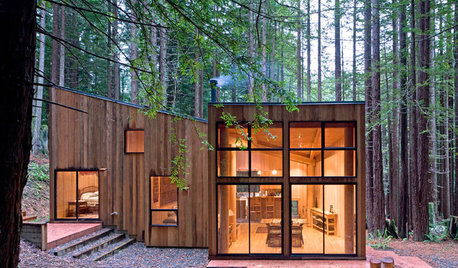Clearing out the bad stuff in my woods
Hi, I'm new to this and not sure what anything is in my woods but know that some things have to go. I want to keep the woodland and I like the foresty look, but the thorny, weedy and poisonous stuff (along with dead stuff) needs to go. My problem is I need an education on what all of it is and how to turn it into a beautiful shaded woodland that I can enjoy. My dh likes to keep it "woodsy", meaning he doesn't want me to touch it, but it needs cleaned up bad. I also think we can have a "woodsy" appearance by replacing some of the nasty stuff with beautiful plants and understory trees. Any advice? Also, is there a good book that will show me pictures of what all the bad stuff is to take out?
Thank you.
Comments (26)
Judy_B_ON
20 years agoGet a good field guide for your area to identify what you have. The Peterson guide to trees and shrubs has all the woody; Newcombs guide to wildflowers covers flowers, flowering vines and flowereing shrubs, the Lone Pine series one for NorthEast Forest has fewer plants but most of the common things and also includes some wildflowers, ferns and mosses.
If you take out everthing poisonous and thorny, you won't have much left! Learn your plants and don't eat the poisonous ones. Remember that blackberries and raspberries have thorns, but also produce great tasting fruit.
Dead wood is good for woodlands; it provides cover and food for insects which provide food for birds. Dead wood also will result in beautiful mushrooms which break it down to return nutrients to the soil. The Peterson guide to Eastern forests provides great info about the life cycles in forests.
Put a few pathways into your woods and walk them in all seasons. Get to know the plants, insects and birds. Only then decide on what "has to go". You may acquire an appreciation for Mother Nature and agree with dh.
natureperson
Original Author20 years agoThanks for the info. I'll take a look at it.
I love birds and squirrels and all the critters that live in the woods and have bird feeders and baths around my yard for them. I just like it to have a bit of a "clean" look. If I had no appreciation, I'd rip it all out like my neighbor is currently doing. However, I know I wouldn't be happy with having no wildlife around. I continually plant shrubs and flowers that they like for the summer and winter months so even if I pull some items out, I would like to replace them with something hopefully equally suitable to the wildlife.
Related Professionals
Glen Ellyn Landscape Architects & Landscape Designers · Mountain Brook Landscape Architects & Landscape Designers · River Forest Landscape Architects & Landscape Designers · Bethlehem Landscape Contractors · Lees Summit Landscape Contractors · Lemoore Landscape Contractors · Oak Forest Landscape Contractors · Casselberry Landscape Contractors · Evanston Fence Contractors · Goodyear Fence Contractors · Kendall Fence Contractors · Troutdale Fence Contractors · Winnetka Fence Contractors · Lincoln Siding & Exteriors · Winchester Siding & Exteriorsshadowgarden
20 years agoThe secret is leaves of three
let it be(it might be poison ivy) although lots of nice plants have three leaves.
leslies
20 years agoIn Massachusetts you have at least five kinds of bad weeds: poison ivy, which is native but not nice, garlic mustard, which is both non-native and invasive, multiflora roses - non-native and invasive, raspberries, which are thorny and (contrary to what another posted has written) not very productive of edible berries and various shrub honeysuckles - invasive and non-native. In addition, the multiflora roses may be hosting a type of mite that is carrying a disease that is fatal to garden roses. My personal opinion is that if you can get some control over any or all of these, you are doing a good deed. Be warned, though, it could take you some time (like, years) to beat back some of these monsters and there's no point in planting anything else until you get the job done.
The best time to deal with raspberries and garlic mustard is very early spring because a lot of the more desirable plants aren't awake yet. You can spray RoundUp that early on without massacring every living thing out there. Roses are a little harder to get because they green up later, but when they bloom in June, them are easy to recognize.
Try to learn to recognize the more common good guys like ferns, mayapples, solomon's seal and jack-in-the-pulpit. You probably have some of all of these in your woods.
Be careful working in the woods. There is more than one kind of tick-borne disease you can get and none of them are pleasant. Use DEET and don't stay in the woods for more than an hour or so. Come right back in the house, change clothes and do a tick search before going back out into the garden or getting on with the rest of the day.
Here is a link that might be useful: garlic mustard
waplummer
20 years agoFirst as Judy said you have to identify the "bad" stuff. maybe some of it is not so bad. In our woods we cleared out some of the hawthorn, but also left some. We still have a few brambles that keep coming back, but so what? Definitely put in paths so you can enjoy your woods. I have paths snaking through our woods forming islands planted with wildflowers and ferns. Leave some of the litter that is on the forest floor. If your woods are anything like mine you would be hard put to find space for flowering trees. I have dogwoods planted years ago, they have grown slowly and flower sparsely. They do best on the edges of woods which also reduces infection from anthracnose. Check out My Page.
Knarly_6
20 years agoLearn to I.D.the weeds and the wild flowers.The public Library is a good source.
Take stock in what you have in your woods.
Decide on a plan.Depending on how large an area we are talking about .Start with the part of the woods that is closest to your house and work on that first.This may take several years but what a wonderful way to injoy nature and get some exercise in the bargain.eartha_diggs
20 years agoA good place to learn about the plants is Garden in the Woods -- since it's in Massachusetts, and so are you. I recommend a visit to look and learn. They have many native plants in their gardens, and sell native plants in their nursery, so you can see examples of many plants. They also offer excellent courses on plant ID and native plants -- a great way to learn more about what's in your woods. If you're in Western Mass and don't want to drive to Framingham, a less extensive set of courses is offered in West Stockbridge at Berkshire Botanical Gardens.
Bill Cullina of New England Wildflower Society (main office is at Garden in the Woods) has an excellent book on native trees, shrubs and vines that you might enjoy.
Another way to find out what is on your property might be to invite an invasive plants volunteer from IPANE (Invasive Plant Atlas of New England) project to do a survey of your property. Generally they work on public grounds, but if you contact IPANE and ask, there may be a volunteer who would do a survey of your property for the IPANE project, and in the process, let you know what's invasive and what's native. Check out the IPANE website for contact info, or call New England Wildflower Society, who could probably also direct you.
debrapaula
20 years agoThanks to all of you-your discussion is very interesting. The issue of INVASIVE PLANTS is urgent these days. Learn to identify the plants that must be removed, or else they will aggressively wipe out everything else, including the native host plants for local wildlife. A great resource is the New England Wild Flower Society's website that lists the invasive plants of Massachusetts and links to the other New England States. You can also see them displayed at the Invasive Plant exhibit at Garden in the Woods April 15-October 31st. Do you want to learn about the plants in your own backyard and help the environment at the same time? Invasive plant volunteers are needed throughout New England. Volunteer to be an IPANE volunteer through the Society and get free training from Chris Mattrick-expert botanist and invasive plant specialist. Contact him at cmattrick@newfs.org.
Here is a link that might be useful: New England Wild Flower Society website
Esopus
20 years agoHi Nature person,
I could have written the very same threat you started, almost word by word.
I recently acquired a large piece of woodland. I love natural forests as opposed to "manicured forests" but still, this forest has way too much "ugly stuff" growing everywhere, and I don't need to read any book to know what I want and don't want to look at.
Anything that is thorny and unattractive should be kept in very small amount, or removed completely. You can take out all that stuff and plant thornless fruiting shrubs that look beautiful and also attract wildlife. Everybody wins right? Well, wrong.
You've got to be very careful with what you do. The patches of the forest that are inaccessible and uninteresting to you are also uninteresting to deer.
You can clear out all that thorny, poisonous, and ugly stuff and plant beautiful blueberries and the deer will now eat them --the next day you plant them-- and leave you with nothing. You may hope to create an "enchanted forest" with berries and wildflowers of your choice, and what you'll end up will be a roaming paradise for deer where nothing grows taller than five inches. Got to know what you're doing or you may inflict irreparable damage on the ecosystem.
Feather_Inc
20 years agoI have 7 and a half acres of woods that we are also turning into a woodland garden. Ther is a heard of 15 or more deer that roam our property and everyone elses. I have seen the buck a time or two, he is a big boy. I feel that deer are as much apart of a woodland garden as the native plants and flowers. A good way to keep them away from the beauties you want to protect it to find a good source for horse manure. I have kept horses in the past and discovered that in a field deer will often graze with horses and like horses they won't grace in areas where they have gone to the bathroom. If a horses pasture isn't cleaned then they only use the bathroom in specific areas. So around the plants you want to protect add horse manure and the deer will stay away from them.
Esopus
20 years agoFeather Inc,
I was about to try impregnating certain spots with coyote scent. Expensive proposition though!
Can you talk about your approach in more detail? I have a hundred acres of woodlands where I'm trying to introduce a number of wild grasses, fruiting shrubs, and wild cherry and apple.
This is for the purpose of attracting bear which now leave the forest too frequently in search of the palatable plants they find in the gardens of neighboring homes.
My concern all along has been that deer will get to anything I plant way before it has a chance to grow.
Does this only work with horse manure? How much of it is necessary? How long does the effect last? Does this work with goat, or sheep manure?
Thanks
Flowerkitty
20 years agoYou are lucky you have such good advice to avoid making the mistakes I did. After the previous owner warned me of poison ivy I started to clear out vines, 'weeds' etc overwhelming fences and trees on one property line. Halfway down ran into a screaming flock of little birds who had some sort of a condo in the vines. They were coming out with berries in their mouths to curse me. Oh the guilt. THEN I started to investigate what I had done. I was mostly pulling down virginia creeper. But even the wild grape, raspberries etc formed a protective home for what I now know are marsh wrens. When I started cleaning, that neighbor felt guilty so they cut down a bunch of dead trees and removed most bushes on their side which had been wild a long long time. Left those precious birds open to the hawks who feed daily there now. And it looked better wild. Plants are continually sprouting that look like lousy 'weeds' and then surprise me with their beauty. Go slow. I am concentrating this year on adding protective bushes, removing a norway maple, possibly digging out part of a pond. In the civilized area by the house I will do normal gardening. In the wild area I am going to try to add, not subtract plants. The hard part is identifying stuff. And breaking the habits of suburban gardening where you pull up anything that moves into your territory, flatten and divide out the land to make it into a clean, bugless extension of the family room.
drema_dianne
20 years agoWow, Leslie thanks for the info about garlic mustard. I didn't know what it was, I just knew I had it all over the place. Sounds like I will never get rid of it, but at least I know a little bit about what I have been doing wrong. That does it, next year I am tearing it up as I see it. It really digs in and towards the end of the summer, you can't even pull it out. Tough little plant. I have something else I hate, too. I am going to take a picture of it, next year so you guys can identify it. I thought that honeysuckle would bloom if I put it in the sun. Are you saying it is just junk? I actually transplanted some in hopes that I could get some nice flowers. Ooops. Guess I better tear it out, and buy the good stuff.
leslies
20 years agoAlmost all honeysuckles now in commerce are non-native lonicera japonica cultivars and most are invasive. The particular problem I have isn't honeysuckle vines, but honeysuckle shrubs (also a lind of lonicera). The flowers look the same but are scentless.
Better to find something else to plant. Ever consider clematis integrifolia or something like that?
john_mo
20 years agoFor a native honeysuckle vine, the native L. sempervirens or trumpet honeysuckle is attracive (to people and hummingbirds), pretty hardy (I have had good luck in zone 5/6), and non-invasive. It tolerates moderate shade, but seems to need sun to bloom well for me.
Here is a link that might be useful: Lonicera sempervirens
ScottReil_GD
20 years agoLots of good stuff here, but a few bugaboos too...
Flower Kitty, you weren't trying to do bad things; I think you had the right idea at heart, but just went after the wrong plants. Lots of people here want to rip down poison ivy and that's just WRONG! Number 4 usage plant for wildlife in the Northeast and I suspect high values elsewhere too. Leslie's list is pretty good (I don't rip out Rubus), but I'd like to add Japanese barberry and Burning Bush. Both are popping up in the woods with increasing frequency; barberry is the worst of the lot for deep woods. You can recognize it easily in spring as it's the first thing to leaf; a bright chartreuse to make it even simpler.
Ripping out barberry and mulltiflora rose is hard, nasty work until you get the right tool. Now that I have that tool, it has become sort of a savage joy, a ritual sap-letting frenzy that brings me great joy and cleans the forest of NNI's with amazing rapidity (God bless my friend Rose Hiscus at the Connecticut Invasive Plant Council for telling me about the Weed Wrench).
There is a size to fit everyone (I have a heavy AND a medium) I have removed a 2" caliper locust tree in 15 seconds (and got most of the root) with the large and the medium is the perfect size for barberry and roses. Gets almost all the roots so you don't have to worry about sucker growth and it does it in a third the time of cutting and a fraction of the time of digging (No, I'm not a paid spokesman; this is my favorite tool, bar none, and if you try it, you'll understand) I have let clients borrow mine and then had a hard time getting it back ("One more day? I'm doing a friends house tomorrow..."); that's how much people like this thing. I watched an 80 year young lady lean into a light Weed Wrench to pop out a 4' barberry and land smack on her keister 'cuz it popped out much easier than she'd anticipated. Bfore I could even offer to help her up, she'd hopped back to her feet with a wicked grin and she was the scourge of the woods for hours, gleefully tearing out bad guys just because she could. So Flower Kitty, don't just add, subtract the real baddies too; just know who they are...
Here is a link that might be useful: Weed Wrench
david7a_ga
20 years agoI'm clearing a woodland understory. The high trees are good natives and appropriate for the site, but I'm getting rid of the privet, thorny eleagnus, Japanese honeysuckle, and English ivy. I'm also getting rid of my poison ivy, but there will still be a lot in the adjacent wild woods.
I'm going back with understory trees and shrubs, mostly native to the immediate area, but stretching a little by planting a few from other parts of the state.BJCP
19 years agoI am about to embark on task of removing Virginia Pine, small multi stemmed hardwoods, brambles and other non desirable growth in my woods to create open "park like" areas as well as covered areas for wildlife. I wish to hear from anyone that has successfully done this without the use of heavy and expensive equipment. I worry about any equipment going in to take out roots as I know it will also compromise the roots of the big hardwoods and white pine that I am keeeping.
My plan is to remove growth with a chain saw down to the ground as closely as possible, either shread or leave piles of branches for wildlife cover until they rot, then use an herbicide like Roundup on all the tree stump sprouts and brambles I am sure to get in the spring. I am doing this work in the winter, so stump treatments are not so effective at this time, so I've read. Eventually, I'd like to plant the "park " with orchard grass and mow once a month in the summer, but I can't figure out how to get grass to grow without turning the soil, and perhaps damaging the big trees that I've kept. My soil is very thin -meaning very litle top soil, so I was considering adding a very small amount of soil - say 2" to get grass started. Any suggestions for turning woods into a park and improving my plan?joepyeweed
19 years agolots of suggestions...
1. grass is not the best ground cover for woodland. consider ferns and other woodland plants like ginger, dutchmens britches, bloodroot, jacobs ladder, jack in the pulpits, may apples... not sure how well those do in virginia - but you may want to look at a woodland in your area and see what grows there. woodland plants dont need any soil improvement and are adapted to growing among the roots of large trees etc.2. i think its wise to try and keep large equipment out - compaction and disturbance will be minimized if you can do alot of handwork. i think you will find that the trees that you remove will rot quicker if you leave a stump of 2' to 4' in place, rather than if you cut it off at the ground. stumps that grow shoots or samplings can be girdled and rarely need round up. round up is really meant to be applied to leaves and disrupts photosynthesis. garlon is stump treatment but i would not use that unless you have a problem with something resprouting. the rotting stump provides decaying matter that will benefit insects and other critters necessary for your woodland. and the roots left in place will help hold soil until something fills in the void. i use a hand saw for trees around 4" or less and a chain saw for larger. but i rarely remove the very large ones.
3. i think the key to a woodland park is a path. create a path that winds through the area...
4. learn about prescribed fire. its the easiest way to create that parklike feeling that you are trying to obtain. you can hire a professional to help you and it may save you alot of work... and will probably be required for longterm maintenance
5. if you open up the canopy and do some burning you may find a dormant seedbank spring back to life. i would hold off on planting anything new until one season after the canopy work and a fire - there may be tons of understory woodland plants that will start growing when given the light and fire that they have been waiting for.
Judy_B_ON
19 years agoBJCP:
Sounds like you are trying to create savanna: open grassland with scattered trees. The forest provides lots of wildlife habitat as it is and the critters that like the forest will not like the savanna, so you will be displacing wildlife not creating space for it. Unless you cut down most of the trees and all of the conifers, there will be too much shade to grow grass and no room to mow.
If you want park like savanna, consider converting your lawn to that look by planting a few widely spaced trees in the lawn -- much easier to convert lawn to savanna than to convert forest to savanna.
Chris_MI
19 years agohere in MI, Poittfield parks, we have garlic pull events in the early spring and it comes out easily. the buckthorn kill is late fall, this plant is the only thing left with green leaves, so it is cut short, and within 3 minutes dabbed with shrub strength round-up (put the mix, with some stong coloring, into a device that is used for dishes with a tube and sponge on the end). if you have streams and marshy areas, beware of poison sumac, a understory tree that has beautiful red leaves (looks nothing like staghorn sumac), white berries, and is 4 times worse than poison ivy. just remember go slowly, and don't try to do the whole area in one year.
BevNC
19 years agoI have just moved to NC and have 8 acres of woods, too. I dont know what to do with all the downed trees, limbs, and saplings. I would like to walk through my woods daily, but cant now. It is very dangerous with lots of stuff on the ground including large rocks I cant see due to all the trees and leafs and limbs everywhere. Any ideas where I can start to clean up enough to enjoy it out there. we are wildlife nuts and enjoy the birds etc. my 8 acres in totlaly fenced in. any help would be appriciated. Bev from NC
Elaine_NJ6
19 years agoThe downed trees and limbs are your future soil. The saplings are your future trees. If you get rid of them, the land cannot continue to renew itself. Educate yourself, get rid of invasives as best you can, and leave the rest.
john_mo
19 years agoBev,
I agree with joepyeweed's comments about woodland paths. You don't need to clear the whole understory to be able to enjoy the area safely. I suggest you spend a year or two establishing a path and getting to know what is growing in your woodland before you do any aggressive clearing.
intheforest
19 years agoYou have gotten some good advice here - most of my points have already been made - especially about the key invasives to target and the importance of brush/logs/soil benefits. The peterson's eastern forests guide mentioned is a good starter book if you can't purchase several specific guides.
Garlic mustard can be tackled mid winter by several methods when snow is melted b/c it is green most of the winter as basal leaves waiting to grow & seed-good winter project and I hear warm days coming this week...
It can be controlled but takes a ton of work if it already has a strong hold.Also, my berries produce differently each year - last year I had tons of blackberies but very few rasberries, whereas the previous year I had tons of ras but NO blackberries - I thought they weren't producers but was proven wrong. These Rhus Species need control in your situation but are so benificial to wildlife you should leave some. Just remember if you trim them drastically they may not fruit (a good time to prune flowering/friuting shrubs is just after they finish so they can make new growth before fall which is where the flower/fruit is.)
Another good place to learn is by taking guided nature hikes at nearby parks (try several-even better if you can find different people to go with for different perspectives.) I'm leading an Owl walk tommorow night at my park...

















odonata_va